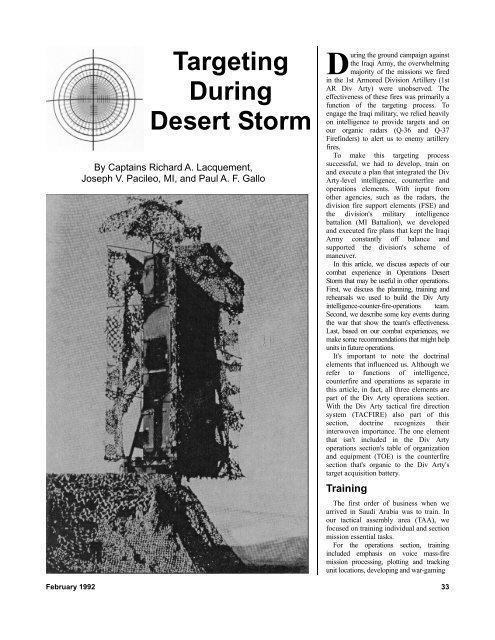February - Fort Sill - U.S. Army
February - Fort Sill - U.S. Army
February - Fort Sill - U.S. Army
Create successful ePaper yourself
Turn your PDF publications into a flip-book with our unique Google optimized e-Paper software.
Targeting<br />
During<br />
Desert Storm<br />
By Captains Richard A. Lacquement,<br />
Joseph V. Pacileo, MI, and Paul A. F. Gallo<br />
D<br />
uring the ground campaign against<br />
the Iraqi <strong>Army</strong>, the overwhelming<br />
majority of the missions we fired<br />
in the 1st Armored Division Artillery (1st<br />
AR Div Arty) were unobserved. The<br />
effectiveness of these fires was primarily a<br />
function of the targeting process. To<br />
engage the Iraqi military, we relied heavily<br />
on intelligence to provide targets and on<br />
our organic radars (Q-36 and Q-37<br />
Firefinders) to alert us to enemy artillery<br />
fires.<br />
To make this targeting process<br />
successful, we had to develop, train on<br />
and execute a plan that integrated the Div<br />
Arty-level intelligence, counterfire and<br />
operations elements. With input from<br />
other agencies, such as the radars, the<br />
division fire support elements (FSE) and<br />
the division's military intelligence<br />
battalion (MI Battalion), we developed<br />
and executed fire plans that kept the Iraqi<br />
<strong>Army</strong> constantly off balance and<br />
supported the division's scheme of<br />
maneuver.<br />
In this article, we discuss aspects of our<br />
combat experience in Operations Desert<br />
Storm that may be useful in other operations.<br />
First, we discuss the planning, training and<br />
rehearsals we used to build the Div Arty<br />
intelligence-counter-fire-operations team.<br />
Second, we describe some key events during<br />
the war that show the team's effectiveness.<br />
Last, based on our combat experiences, we<br />
make some recommendations that might help<br />
units in future operations.<br />
It's important to note the doctrinal<br />
elements that influenced us. Although we<br />
refer to functions of intelligence,<br />
counterfire and operations as separate in<br />
this article, in fact, all three elements are<br />
part of the Div Arty operations section.<br />
With the Div Arty tactical fire direction<br />
system (TACFIRE) also part of this<br />
section, doctrine recognizes their<br />
interwoven importance. The one element<br />
that isn't included in the Div Arty<br />
operations section's table of organization<br />
and equipment (TOE) is the counterfire<br />
section that's organic to the Div Arty's<br />
target acquisition battery.<br />
Training<br />
The first order of business when we<br />
arrived in Saudi Arabia was to train. In<br />
our tactical assembly area (TAA), we<br />
focused on training individual and section<br />
mission essential tasks.<br />
For the operations section, training<br />
included emphasis on voice mass-fire<br />
mission processing, plotting and tracking<br />
unit locations, developing and war-gaming<br />
<strong>February</strong> 1992 33
















